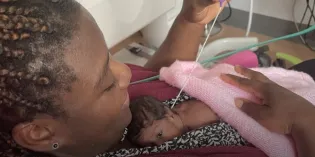The Workforce briefing winter 2018 report has revealed that patient demand is strongly outstripping the supply of doctors as the usual seasonal increase combined with a rise in children’s emergency admissions is placing unprecedented demand on services.
The report reveals chronic understaffing in clinics with demand for paediatric consultants in the UK around 21% higher than 2017 levels with clinics falling 850 consultants short of being able to provide a safe and sustainable service. Meanwhile, with winter pressures hitting the service, paediatricians across the country are reporting that staff are being pulled from treating children to deliver care to adults.
The report, which sets out headline results in advance of the full report being published in January, also reveals:
- Approximately 600 additional training posts each year for the next five years are needed to account for the growth in less than full time working, doctors taking on different roles and the high level of doctors dropping out of training altogether.
- RCPCH estimates that demand for paediatric consultants in the UK is around 21% higher than 2017 workforce levels, meaning an additional 850 are needed across the UK.
- The number of consultants working less than full time working (LTFT) in the UK has increased to 24.2% in 2017, up from 21.5% in 2015.
- The number of applicants to paediatric training from the European Economic Area (EEA) fell from 97 in 2015 to 41 in 2017, a 58% fall in two years.
- The consultant paediatric workforce in the UK grew from 3,996 in 2015 to 4,306 in 2017, representing a 7.8% rise in headcount but only 6.4% in terms of Whole Time Equivalents (WTE) since 2015. Meaning for every additional consultant the increase in whole time equivalent is only 0.77 WTE.
- Vacancy rates are increasing - 11.1% on tier 1 (junior) rotas and 14.6% on tier 2 (middle grade) rotas* ; in 2015, these were 6.3% and 13.7% respectively.
- Employment levels for Advanced Nurse Practitioners, Physician Associates and of trainee GPs working on junior paediatric rotas remain unchanged since 2015.
Between 2013-14 and 2016-17 there was a 13% rise in children’s emergency admissions in both England and Scotland. In Wales, this number increased to 17%, which doctors say is placing unprecedented demand on services.
Professor Russell Viner, President of the Royal College of Paediatrics and Child Health, said despite paediatrics seeing a slight increase in its consultant workforce over the last two years, the increase in demand, combined with growth in less than full time working, has meant there are not enough doctors coming through the training programme to provide the best care for their young patients. He said:
Paediatrics is a family friendly specialty and we pride ourselves in having a work ethos that reflects that. This is one of the many reasons why so many of our doctors choose to work less than full time. Therefore, we must take this into account when we calculate the number of doctors needed to train and work in paediatrics. Across tier 1 rotas, 11.1% of posts remain unfilled, increasing to 14.6% for middle grade rotas, resulting in an overstretched workforce who find themselves exhausted and at risk of becoming sick themselves.
In reality, due to the modern style of working our doctors quite rightly favour, we have the equivalent of ¾ of each doctor employed, available to actually deliver care. That’s why we urgently need hundreds more, allowing paediatrics to be a modern career choice and one that fosters the health and wellbeing of our members and our patients.
The findings from this report has led to calls from the UK’s most senior paediatrician for policymakers to:
- develop a bespoke child health workforce strategy with additional funding for England, Northern Ireland, Wales and Scotland, modelling the paediatric and child health workforce up to 2030
- recruit and train an additional 600 paediatricians in the UK in each training year for the next five years
- fund an additional year of General Practice (GP) training to include paediatric and child health training for all GP trainees
- expand the Medical Training Initiative scheme, which allows doctors from outside the UK to train and develop their skills in NHS
- offer financial incentives to paediatricians returning to clinical practice after completing recognised activities such as research, to paediatric trainees upon joining the specialty and for hard to recruit areas
- commit to permanently removing the tier 2 cap so that the UK attracts paediatricians overseas with the right skills into the NHS.
A recent winter pressures survey of emergency care professionals, led by the RCPCH, echoed many of the concerns raised in the Workforce Briefing Winter 2018 report, citing pressures on staffing and a rise in attendance as key drivers for this pressure. However, it also revealed that staff rostered for children’s departments are being pulled away to treat adult patients.
The RCPCH winter pressures survey, which sought views from over 250 frontline emergency care professionals, found:
- The three main pressures faced in emergency departments during the winter period are workforce shortages (35%), bed pressures (23%) and a rise in attendance (18%).
- Shortages in nurses are the biggest problem in emergency departments and on the ward in winter, resulting in bed closures.
- Higher pressures in emergency departments were cited as preventing staff from taking adequate breaks, resulting in staff burnout and fatigue, often leading to increased sickness.
- Staff are pulled from treating children to deliver care to adults.
- Forty six percent of 147 respondents said either no additional medical staffing was offered or services had challenges in recruiting locum shifts, either because of financial constraints or poor uptake.
- A third of respondents said recruiting additional child health professionals could help alleviate winter pressures in emergency departments (33%).
Dr Simon Clark, Workforce Officer for the Royal College of Paediatrics and Child Health said:
The winter pressures survey highlights just how important investment in the whole child health workforce is. Our survey shows that nurse shortages are the biggest staffing problem faced by emergency departments and paediatric wards in winter, and this leads to bed closures. If we do not have the beds, we cannot treat the patients and that means children are missing out on important care.
The winter months are known to make children vulnerable to illness so to learn that staff are being removed from paediatrics to support adult patients is completely unacceptable. Children are equally as vulnerable as the elderly at this time of year and should not be treated as second class citizens.
- *Tier 1 rotas are made up of junior trainees, and tier 2, or middle grade, rotas comprise senior trainees.










